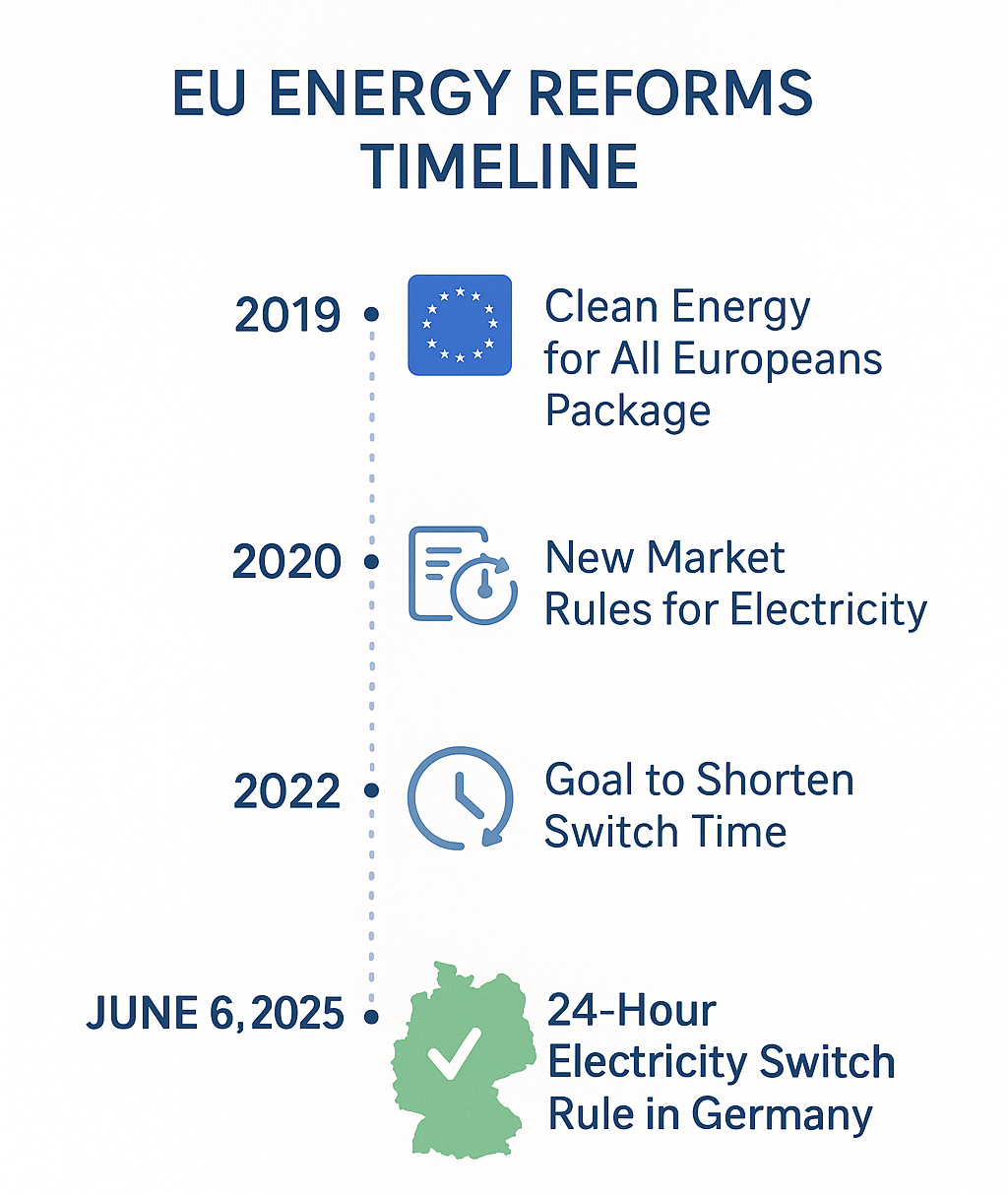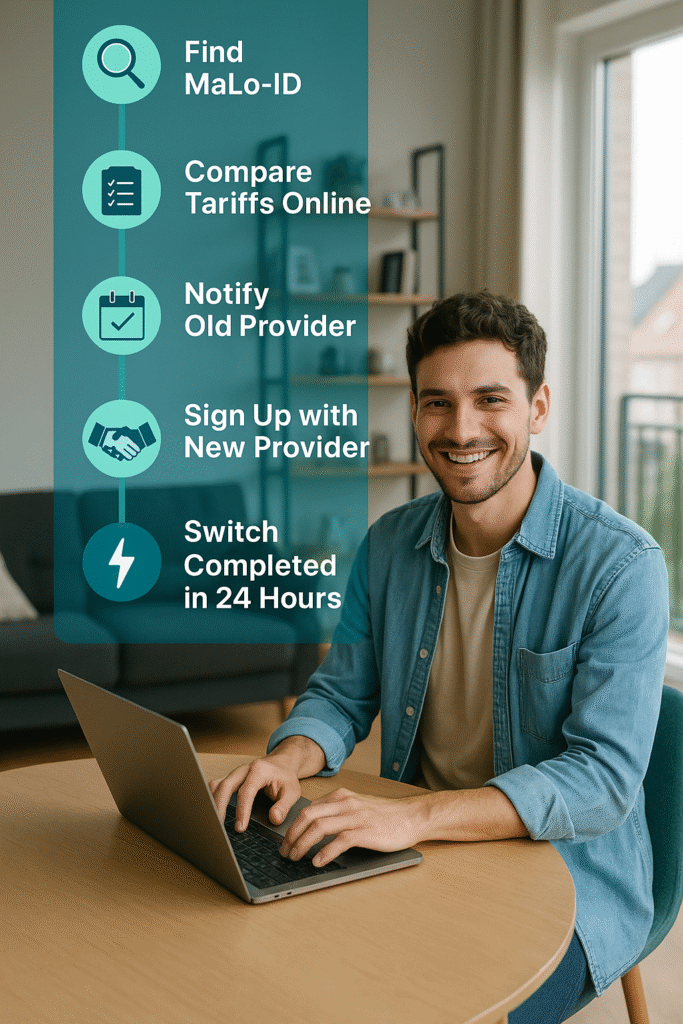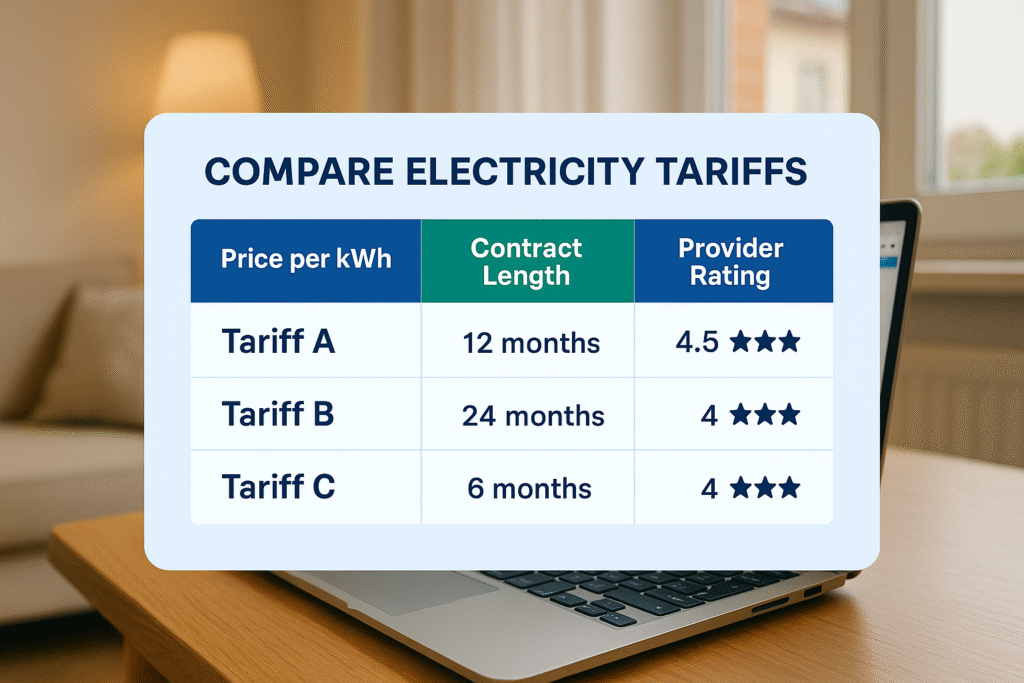
Starting June 6, 2025, Germany will implement a new rule that allows consumers to switch electricity providers within 24 hours. This update is part of a broader EU-wide reform aimed at making energy markets more competitive and consumer-friendly. For anyone living in Germany, especially expats, this is big news.
Let’s be honest: navigating the utilities system here can feel like wrestling a stack of paperwork in a language you don’t quite understand. Contracts, meter readings, cancellation deadlines, MaLo-ID, it’s a lot. And while switching can save you money, most English-language resources don’t explain how it works. That’s where we come in.
Whether you’re a new arrival, a long-time resident, or just someone tired of paying too much for power, this guide is for you. We’ll break it all down, what the 24-hour switch means, how to find your MaLo-ID, and how to compare tariffs without getting lost in the fine print.
Here’s a quick reason to pay attention:
Over 30% of households in Germany have switched electricity providers in recent years, saving an average of €150 per year. With the new rule, those savings are easier to access than ever.
We know that German bureaucracy can feel overwhelming, but don’t worry – we’ve got your back.
Understanding the 24-Hour Switch Rule
If you’ve ever tried switching electricity providers in Germany, you know it’s not exactly quick. Until now, the process has taken weeks, even months, with lengthy cancellation periods and unclear timelines.
But as of June 6, 2025, that’s changing. A new EU-backed rule means all electricity provider switches in Germany must be completed within 24 hours.
What’s the Rule?
Once you agree to a new electricity contract, your switch must be completed within one business day. This applies whether you’re changing providers or moving into a new home and setting up service.
No more waiting weeks for the lights to come on or your cheaper tariff to kick in.
Why the Change?
This rule is part of broader reforms under the EU Electricity Market Design (EMD), aimed at giving consumers more control. The idea is to make it as easy to switch electricity providers as it is to change a mobile phone plan.
It’s a win for transparency, competition, and, most importantly, you.
Why It’s Great for Expats
For expats in Germany, this rule is a game-changer. Here’s why:
- Faster setup when moving into a new flat.
- Quick exits from overpriced or unresponsive providers.
- More freedom to take advantage of better tariffs anytime, without long-term contracts tying you down.
This change levels the playing field, especially for newcomers like you. It means fewer delays, fewer headaches, and a lot more flexibility in managing your energy bills.
Next, we’ll show you how the switch process works under the new system, step by step.

Step-by-Step Guide to Switching Providers
Switching electricity providers in Germany may sound complex, but the new 24-hour rule makes it refreshingly simple. Follow these four steps, and you’ll be switched in no time, with zero disruption to your power.
Step 1: Find Your Market Location ID (MaLo-ID)
Think of the MaLo-ID as your electricity meter’s fingerprint. It’s a unique 33-digit number that tells energy providers exactly where the electricity is being delivered.
Where to find it:
- On your electricity bill, it is usually listed under Zählpunktbezeichnung.
- Alternatively, you can call or email your current provider.
Tip: Lost your MaLo-ID? Please don’t panic, your provider can help you retrieve it quickly.
Step 2: Pick a New Provider
Now the fun part, shopping for a better deal.
Use trusted comparison sites like:
These platforms display available tariffs, estimated monthly costs, and even English-language options (filter or utilize auto-translate features).
Tip: Look for flexible contracts with short cancellation periods and no prepayment.
Step 3: Notify Your Current Provider
If you’re switching before your contract ends or moving out, you’ll need to notify your current provider at least 14 days in advance.
This avoids any risk of slipping into a more expensive default tariff.
Tip: Set a calendar reminder or alarm to ensure you don’t forget this crucial step.
Step 4: Complete the Switch
Once you’ve signed with a new provider, they handle the rest, including the 24-hour switch.
There’s no need for you to cancel anything manually unless you’re moving out.
There’s also no interruption to your electricity during the switch; your power stays on, guaranteed.
The 24-Hour Switch Process

Next, we’ll break down how to compare tariffs and spot the best deals, without falling for hidden fees or confusing terms.
Avoiding Common Pitfalls
We’ve seen expats trip over these issues before: unexpected fees, last-minute panic, and confusing contract terms. The good news? You can avoid all of it with a bit of know-how.
Here’s what to watch for:
Dodging Default Tariffs
Default tariffs (Grundversorgungstarife) are the fallback plans you’re automatically placed on if you don’t choose a provider in time. They’re expensive but straightforward; you’ll pay for the convenience.
Why it matters:
Expats who miss the 14-day switch notice can end up on default tariffs that cost up to 30% more than market-based deals.
Act fast. Even if you’re moving in, choose a provider right away so you don’t get auto-enrolled into a costly plan.
Timing Your Move
Switching providers is easiest when it aligns with a move. If you’re moving into a new apartment, start the switch process at least two weeks before your move-in date.
Why? Because utilities aren’t automatically transferred, overlapping contracts can lead to double billing, especially if your old contract auto-renews.
Tip: Switch when you move to keep it seamless—new address, new provider, no hassle.
Contract Watchouts
Electricity contracts in Germany can be surprisingly lengthy and replete with fine print.
Before signing:
- Check the cancellation period (ideally 1 month or less).
- Avoid contracts with automatic renewals longer than 12 months.
- Watch for prepayment clauses or “bonus” rates that vanish after the first year.
Use comparison sites with filters for “short-term” or “no contract” offers to stay flexible.
Getting caught off guard is frustrating, but with a bit of planning, you’ll stay well ahead of the curve. Next up, we’ll look at comparing tariffs, how to spot the best deal, and how to save.
Choosing the Best Tariffs
Finding the correct electricity tariff in Germany is easier than you think, especially now that switching is faster than ever. The key is knowing what to compare, where to look, and what matters most for your situation.
Let’s break it down.
Comparison Basics
When comparing providers, focus on these three essentials:

- Price per kilowatt-hour (kWh):
This is the base cost of your electricity. Lower is better, but make sure it’s not just a “welcome rate” that disappears after a few months. - Monthly base fee (Grundpreis):
Some contracts have a fixed monthly fee in addition to your usage costs. - Contract length and flexibility:
Look for terms that allow you to leave with one month’s notice. Avoid long lock-ins unless the savings are significant. - Provider reputation:
Stick with well-reviewed providers. Some smaller companies offer great prices but lack service reliability.
Tip: A short-term contract with solid customer support is often the safest choice for expats.
Helpful Tools
These comparison sites make switching simple, and many offer English support or easy-to-navigate interfaces:
Each lets you:
- Enter your ZIP code and estimated usage (in kWh/year)
- Filter by contract length, cancellation terms, and eco-friendly options
- Read customer reviews and see cost breakdowns
Bonus: Some platforms let you complete the entire switch online, in English.
Expat Tips
If German isn’t your strong suit, consider:
- Choosing providers with English-speaking support or multilingual websites
- Reading reviews from other expats in your area (try Reddit or Facebook expat groups)
- Avoiding offers that require German bank-only payments, like SEPA direct debitt with no online banking access
What About Prices?

As of early 2025, Germany’s average electricity price is around €0.40 per kWh (including taxes and fees). That may sound high, but switching to a more affordable provider can reduce your bill by 15–25% per year, depending on your region and usage.
Example:
If you use 3,000 kWh per year, you could save €150–€250 annually just by switching.
Ready to leap? In the final section, we’ll wrap it all up with key takeaways and quick-start tips for your next electricity switch.
Conclusion
Switching electricity providers in Germany has just become quicker, easier, and less intimidating.
Thanks to the new 24-hour switch rule, you no longer have to wait weeks or struggle through German bureaucracy to start saving. Whether you’re moving in, tired of overpaying, or want more flexibility, this update is tailor-made for expats like you.
You’ve got the tools to navigate this like a pro; don’t let high bills hold you back.
Remember:
- Grab your MaLo-ID
- Compare tariffs using trusted sites like Check24 or Verivox
- Set a reminder for the 14-day notice
- And let your new provider handle the rest
You’re just a few steps away from a better deal. Go for it.
Ready to start? Grab your MaLo-ID and take control today!
Please let me know if you’d like me to format the complete blog draft into a final layout (including intro, sections, visuals, and outbound links) or if you’d like me to generate the tariff comparison table or flowchart graphic now.
FAQ: Electricity Switch in Germany (2025)
What is the 24-hour electricity switch rule?
As of June 6, 2025, electricity providers in Germany are required to complete a switch within one business day. This means faster transitions, less downtime, and more flexibility for consumers.
What is a MaLo-ID, and where do I find it?
Your MaLo-ID (short for Marktlokations-ID) is a unique 33-digit code that identifies the location of your electricity meter. You can find it on your electricity bill or by contacting your current provider.
Will my electricity get cut off during the switch?
No. There is no interruption in service. Your physical electricity supply stays the same; it’s just the billing and contract that change.
What happens if I don’t switch providers when I move in?
You’ll automatically be placed on a default tariff (Grundversorgung). These plans are legal but often much more expensive, sometimes up to 30% higher than competitive offers.
How much notice do I need to give my current provider?
Typically, you need to give 14 days’ notice. This ensures you’re not charged for overlapping contracts or stuck with automatic renewals.
How much can I save by switching?
On average, switching providers can save a household €150–€250 per year, depending on your usage and region.
Can I switch providers if I don’t speak German well?
Yes. Many comparison sites like Check24 and Verivox offer English-friendly interfaces. Some providers also provide English customer support.
Can I switch if I’m in a fixed-term contract?
It depends. Some fixed-term contracts allow cancellation if you’re moving out. Check your contract’s Kündigungsfrist (cancellation period) and Mindestvertragslaufzeit (minimum contract term).

